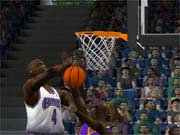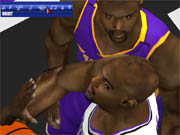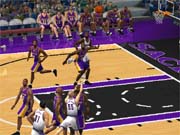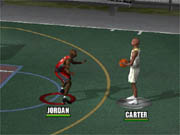EA Sports' NBA Live series arguably hasn't changed much since its 1995 debut on the Super Nintendo and Sega Genesis consoles, but back then, the series was revolutionary. It ushered in the isometric perspective for basketball games, which was previously unheard of since most developers liked to stick with the TV-like sideline camera angle. The gameplay was equally different--for example, the first NBA Live game dramatically increased the speed of the sport with options such as speed bursts and quick post-up moves--but it still managed to seem like an accurate simulation of the real-life sport. The NBA Live series quickly began to grow in popularity and eventually reigned as the premier basketball game across all platforms. But, as the years passed, players started to realize that the successive iterations of the Live series featured fewer and fewer improvements and modifications to the gameplay. The new 2001 edition of the series also continues in the tradition of most of its predecessors in that it doesn't really offer much in the way of new features--but likewise, it's still one of the best basketball games available.

The gameplay modes in NBA Live 2001 are nearly identical to those of its predecessor, NBA Live 2000. There's an exhibition mode in which you select any two teams and jump right into a game. The season mode lets you play through the entire 2000-2001 NBA season, where you can start out with a draft or use the default rosters for each team. Once you actually begin the season, you can reorder your roster, change players' positions, and sign or release players without worrying about whether or not one player is actually more valuable than the other. There's also a basic playoff mode in which you can skip the 2000-2001 season entirely and head straight for the playoffs.
The popular one-on-one mode reappears in NBA Live 2001 with updated rosters, and, for the most part, it's identical to that of NBA Live 2000. This mode lets you challenge the greatest players of all time in a one-on-one game that takes place on an outdoor playground. So, for example, if you've ever wondered if Vince Carter is truly the next Michael Jordan, you can find out by pitting the two against each other. Or, if you want to see who really is better--Michael Jordan or Wilt Chamberlain--you can set up that game as well. The single-player one-on-one mode is executed really well. Even on the highest difficulty setting, in which the computer-controlled player will hang right on your jersey, it's still possible to find a small opening and take the ball right to the basket with a ferocious dunk. In multiplayer, one-on-one sessions are also fun because it's just you and the other player putting on your best show of advanced basketball skills.

The franchise mode also makes a return in NBA Live 2001. It's ideal for those who like to take on the role of general manager in a much more detailed manner than what the regular season mode offers. Once you start a season, you have access to options similar to those found in the basic season mode--you can reorder the roster and edit players, as well as make trades, sign free agents, and drop players. However, unlike in the season mode, each of your actions is influenced by a point total that essentially serves as NBA Live's version of money. For example, if you want to sign Tim Duncan, who's approximately worth 300,000 points, and you have only 120,000 points available for your team, then you can't sign him. But, like a true general manager, you can find ways to get what you want by releasing players, trading current players or draft selections, and signing new players at the right time. Trades operate in a similar manner--you can't just trade a good player for an all-star, so trying to trade Patrick Ewing for Shaquille O'Neal isn't going to work unless you throw in a few more high-quality players like Gary Payton. The only problem with the franchise mode is that the trade menus aren't as intuitive as they should be, so making a simple trade can end up taking more time than necessary. The additional ability to make three-team trades can compound the problem, though it's a welcome feature otherwise.
NBA Live 2001's gameplay does have a few new changes and additions since the last installment. To make up for a rather weak low-post game in NBA Live 2000, EA Sports added a few new moves for players in the blocks, which really helps to change up the pace of the game since posting up is now a little more advantageous. In NBA Live 2000, you'd probably just run down the court and simply throw the ball down to the power forward or the center and try to make a move directly to the basket. But in NBA Live 2001, you can actually take your time and wait for your big men to get set up on the low post, toss the ball to them, watch them go to work, and finish it off with a baby hook or a fade-away jump shot, which is much easier to execute than in previous versions of the game. Unfortunately, in multiplayer mode, the pacing of the game is actually much quicker, and you won't have as many opportunities to set up a low-post offense in any effective manner, which basically defeats the purpose of adding the new moves.

Shooting and passing in NBA Live 2001 largely remain the same as in the previous game, so there are still a few problems in terms of taking specific types of shots and passing the ball to the correct player. In NBA Live 2000, one of the biggest disputes among fans of the game was whether it was realistic or annoying when a player who was standing directly under the basket wouldn't always dunk the ball or go for a simple layup. This behavior continues in NBA Live 2001, and it can still be annoying because you'll expect the player to dunk the ball, so the timing of your jump shot will almost always be thrown off. As a result, your players often miss a shot when they're standing merely two feet away from the front of the basket. It happens so often that you'll become accustomed to seeing it happen, but even so, there's nothing more frustrating than to have an open player under the rim, only to see him miss a wide-open jump shot that could have easily been a dunk layup. In addition, the act of shooting itself is a little sluggish, as players occasionally don't pull off a simple jump shot while making a run to the basket or even while standing.
Passing remains basically the same in NBA Live 2001, but, as with shooting, problems involving responsiveness and precision creep up every now and then. Sometimes, particularly when you're down on the low post, it can take a moment before the player responds to the pass command. Part of this is to compensate for the fact that you can accidentally press the control pad toward the wrong player, but the problem still occurs even when players are directly in front of you. Still, NBA Live 2001's passing game remains relatively smooth: Throwing the ball around the perimeter to a shooter on the other side for a three-point shot or passing out of a layup to the trailing player for the dunk is classic basketball action.

NBA Live 2001's graphics are on par with 2000's, though there are some noticeable enhancements to the players' facial features and to the overall detail, and you can adjust all this to accommodate your hardware. Some of the lesser-known players--primarily the bench players--aren't quite as distinctive looking as some of the starting players, but even they look good. Unfortunately, on the medium detail setting, there are some serious problems with player models switching on the fly between low-polygon and high-polygon versions of themselves. When you're in a large group of players or when the quarter ends and the game cuts to the bench players, this can really take away from the overall visual quality of the game as the detail level of the graphics suddenly and noticeably gets worse. As for the fans watching the game, the fan animation is realistic, but individual fans actually look so odd and deformed that it can seem as if you're playing in front of a large gathering of zombies.
NBA Live 2001 is a great basketball game. The gameplay follows the classic NBA Live formula--perhaps too closely--because of its blend of fast-paced action along with strong simulation elements. The addition of new post-up moves gives some new life to NBA Live's post-up game, but most of the time, everything starts to move so quickly that you're better off just making a strong move to the basket without posting up. The multiplayer mode is also very good, whether you're playing strangers online or a friend on the same computer. But, ultimately, there aren't many new features in this new installment, so if you already have NBA Live 2000, you'll essentially be paying for a roster update. Then again, if you skipped over NBA Live 2000, you shouldn't hesitate to pick up NBA Live 2001.